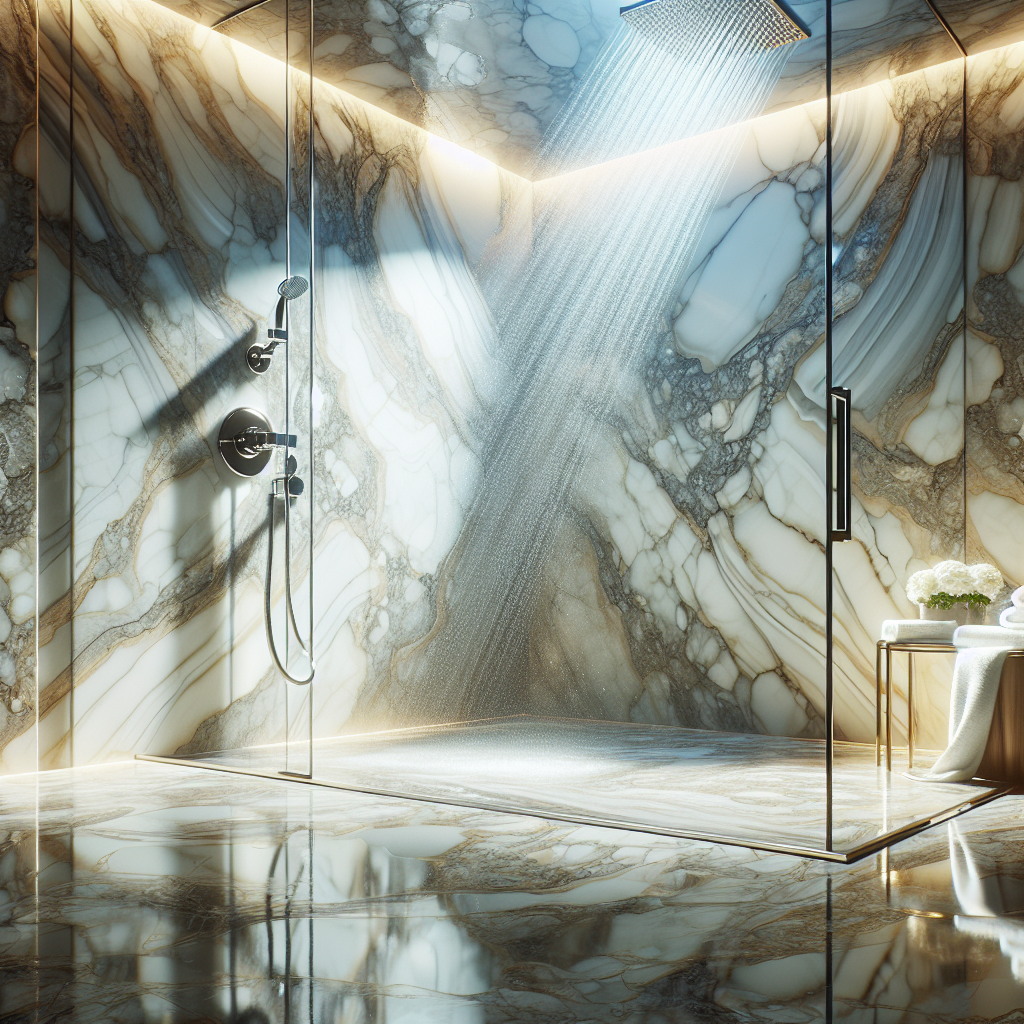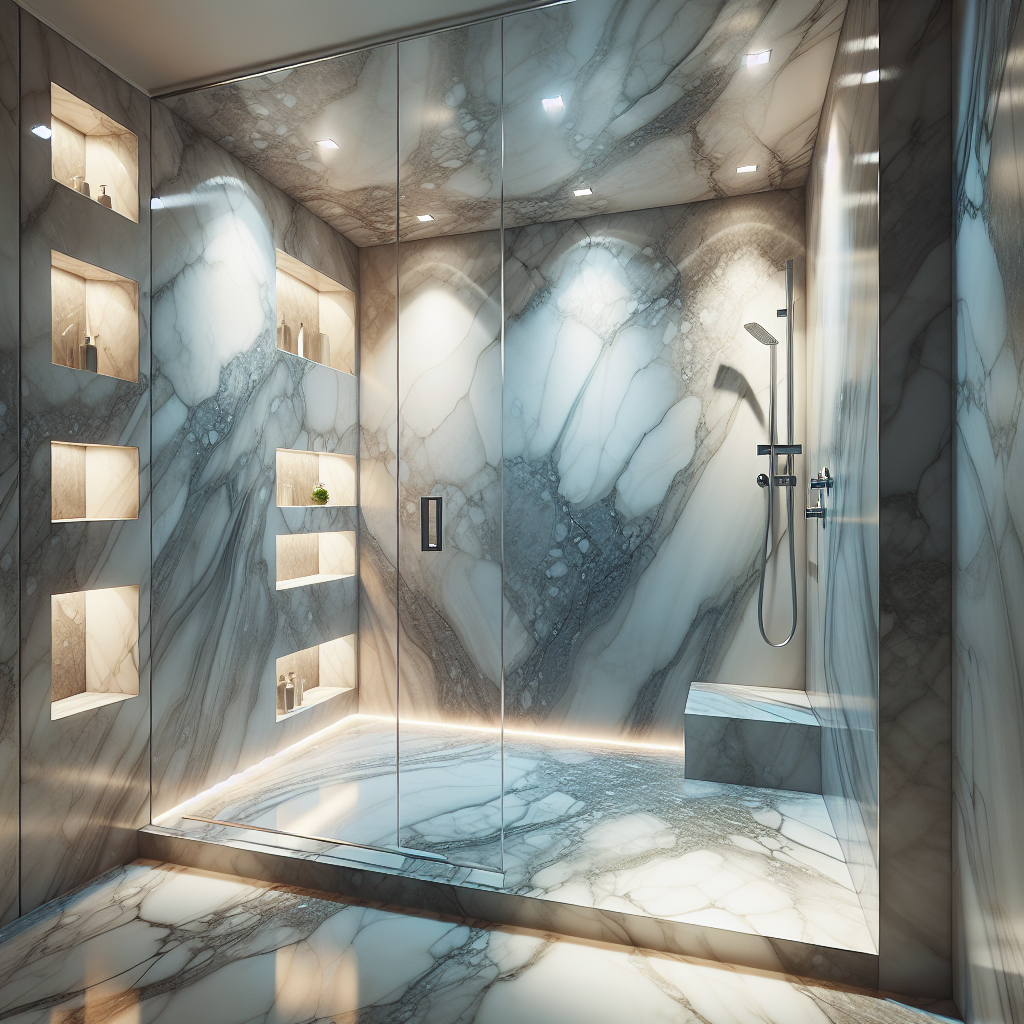
Key Takeaways
Cultured marble showers can be refinished to look brand new, which is often more cost-effective than replacing them.
Preparation is key, including cleaning, sanding, and using the right materials for the job.
Using a primer is essential for paint adhesion on the non-porous surface of cultured marble.
Regular maintenance after refinishing will extend the life and beauty of your cultured marble shower.
With patience and careful work, DIY refinishing is a feasible project for homeowners.
Understanding Cultured Marble
Imagine stepping into a shower that gleams like it’s straight out of a home decor magazine. That’s the allure of cultured marble. It’s a blend of crushed marble, resins, and pigments, cast to create a smooth, shiny surface. It’s tough, water-resistant, and, most importantly, can be refinished to look like new. This is a game-changer for those with dated or worn showers because it means you can revamp without a full remodel.
The Benefits of Refinishing Over Replacing
Why refinish instead of replace? First off, it’s generally more affordable. Replacement can run into the thousands, while refinishing materials are a fraction of that. Besides that, it’s less wasteful. If your cultured marble is structurally sound, it’s more eco-friendly to give it a facelift rather than send it to a landfill. And don’t forget the time saved. Refinishing can be done in a few days, whereas a full replacement might leave you without a shower for weeks.
Pre-Refinishing Preparations
Gathering Your Materials
Ready to transform your shower? Start by gathering your materials. You’ll need a cleaner, sandpaper, primer, paint, sealer, and a few tools. Don’t skimp on quality here – the right materials will make all the difference in durability and finish.
Here’s what to gather:
Cleaner: A non-abrasive cleaner to remove soap scum and oils.
Sandpaper: Fine-grit sandpaper to roughen up the surface for primer adhesion.
Primer: A high-adhesion primer designed for non-porous surfaces.
Paint: A paint that’s suitable for wet environments and adheres to the primer.
Sealer: A waterproof sealer to protect your finish.
Tools: Gloves, safety goggles, a paintbrush, roller, and squeegee.
Setting the Scene for a Seamless Refinish
Before diving in, prepare your workspace. Ventilation is critical – open windows and use fans. Cover anything you don’t want painted with plastic sheeting. And remember, patience is your ally. Rushing can lead to a less than stellar finish, so take your time with each step.

Getting Down to Business: The Refinishing Process
Now, let’s get down to the nitty-gritty. You’ll be cleaning, repairing, sanding, priming, painting, and sealing. Each step is critical to achieve that like-new finish. Let’s walk through each one.
1. Initial Cleaning: What to Watch Out For
Start with a thorough clean. Use your non-abrasive cleaner to strip away any grime, soap scum, or oils. This isn’t just about aesthetics – paint won’t stick to a dirty surface. Pay special attention to corners and crevices where gunk likes to hide.
Remember: You’re not just cleaning for appearance. You’re prepping the surface for refinishing. A clean surface ensures better adhesion and a smoother finish.
2. Repairing: Fixing Cracks and Chips
Even the most well-cared-for cultured marble can develop imperfections over time. Small cracks and chips can be mended with a gel coat or epoxy designed for cultured marble. Fill the imperfection, smooth it out, and let it dry completely. If done right, these repairs will be almost invisible once you’ve finished the entire refinishing process.
3. Surface Sanding: Techniques for a Smooth Base
After repairs, it’s time to sand. Sanding creates a rough surface for the primer to cling to. Use fine-grit sandpaper and sand the entire surface evenly. Take your time here; consistent sanding will prevent an uneven finish later. Wipe down the surface with a damp cloth to remove any dust when you’re done.
4. Primer Application: Ensuring Proper Adhesion
Primer is the unsung hero of the refinishing process. It’s what makes your paint stick and not flake off a few months down the line. Apply a high-adhesion primer with a brush or roller designed for smooth surfaces. Let it dry according to the manufacturer’s instructions—usually, this takes at least a few hours.
5. Painting: Choosing and Applying the Right Product
With your surface primed, it’s time to paint. Opt for a high-quality acrylic or epoxy paint that’s designed for bathrooms and can handle moisture well. Apply with a smooth roller for an even coat. You’ll likely need several coats, so don’t rush it. Let each layer dry thoroughly before applying the next.
When painting, use a zigzag pattern to roll on the paint, then smooth it out with straight, even strokes. This technique helps prevent streaks and ensures full coverage.
After painting, the transformation is really starting to show. The once dull and scratched surface should now have a uniform, glossy appearance that’s starting to look like new.
6. Sealing: Protecting Your Hard Work
Finally, seal your hard work. A good sealer will protect the paint from water, mold, and mildew. Apply it as directed, usually with a brush or roller. Be sure to cover every nook and cranny for full protection. This is your waterproof barrier, so it’s essential not to skip this step.

Aftercare: Maintaining Your Refinished Shower
After the paint and sealer have dried, it’s time to think about maintenance. The right care will keep your shower looking great for years to come.
Routine Cleaning Practices
To maintain your shower’s shine, clean it regularly with a soft cloth and a non-abrasive cleaner. Avoid harsh chemicals or scrubbers that can damage the surface. And always rinse thoroughly with water after cleaning.
Here’s a simple routine:
After each shower, use a squeegee to remove water from the walls.
Weekly, wipe down the shower with a mild cleaner.
Monthly, inspect for any signs of wear or damage.
Preventing Damage and Stains
Preventative measures are just as important as regular cleaning. Be mindful of what you bring into the shower. Shampoos, soaps, and cleaners that contain dyes or harsh chemicals can stain or damage the surface. Stick to products you know are safe for cultured marble.

Common Pitfalls and How to Avoid Them
Even with the best intentions, mistakes can happen. Let’s talk about some common pitfalls and how to steer clear of them.
Mistakes in the Sanding Process
Sanding can make or break your refinishing job. Here are some tips to avoid common sanding mistakes:
Don’t sand too roughly; you can create grooves that will show through the paint.
Don’t skip sanding; primer won’t adhere to a smooth surface.
Always clean off the sanding dust; it can create a bumpy finish.
With these steps and precautions in mind, you’re well on your way to a beautiful, like-new cultured marble shower. It’s a bit of work, but the results are worth it. Enjoy your refreshed space!
Ideas for Accentuating Your Freshly Refinished Shower
Install new hardware such as a modern shower head or sleek faucet handles to complement the refinished marble.
Add a teak wood shower mat or bench for a touch of warmth and spa-like luxury.
Consider frameless glass doors to showcase the marble and make the space appear larger.
Now that your shower looks brand new, it’s the perfect time to add some personal touches. Think about what kind of atmosphere you want to create. For a serene, spa-like feel, incorporate elements from nature like bamboo accessories or pebble bath mats. If you’re after a more luxurious look, add a touch of gold with new towel bars or cabinet pulls. Remember, it’s the details that make a space feel complete.
Lighting also plays a significant role in how your bathroom feels. Consider installing a dimmer switch for your lights to adjust the ambiance or add LED strip lighting under shelves for a modern glow.
Don’t forget about storage. Now that you have a beautiful backdrop, it’s important to keep clutter at bay. Use shower caddies or install recessed shelving to keep your essentials organized but out of sight.
Tips for Coordinating With Existing Bathroom Decor
When you’ve invested time and effort into refinishing your cultured marble shower, you’ll want to ensure it fits seamlessly with the rest of your bathroom’s decor. Use color accents from your shower in other parts of the bathroom, like towels or a bath mat, to tie the room together. If your marble has veining, consider matching these tones to other elements in the room, such as the vanity or wall color.

FAQ
How long does it take for the refinishing to dry?
Generally, it takes around 24 to 48 hours for the refinishing to dry and cure properly. However, this can vary based on the specific products used and the conditions in your bathroom, such as humidity and temperature. Always check the manufacturer’s instructions for the best guidance.
Can I refinish my cultured marble shower myself?
Yes, with the right tools, materials, and a bit of patience, you can refinish your cultured marble shower yourself. It’s important to follow each step carefully and allow proper drying time to ensure a professional-looking finish.
What type of paint should be used on cultured marble?
Use a high-quality acrylic or epoxy paint that’s formulated for bathrooms and can withstand moisture. These paints are designed to adhere to non-porous surfaces and will provide a durable finish that lasts.
How often should I refinish the cultured marble in my shower?
With proper care, a refinished cultured marble shower can last many years before needing another refinishing. However, if you notice signs of wear or damage, it’s time to consider refinishing again. This might be every 5-10 years, depending on usage and maintenance.
Is it necessary to sand the cultured marble before refinishing?
Yes, sanding is a critical step in the refinishing process. It creates a rough surface for the primer to adhere to, which is essential for a long-lasting finish. Skipping this step can result in paint that peels or chips prematurely.
Refinishing your cultured marble shower can be a rewarding project that breathes new life into your bathroom. With these tips and steps, you’re equipped to take on the task and achieve stunning results. Happy refinishing!



